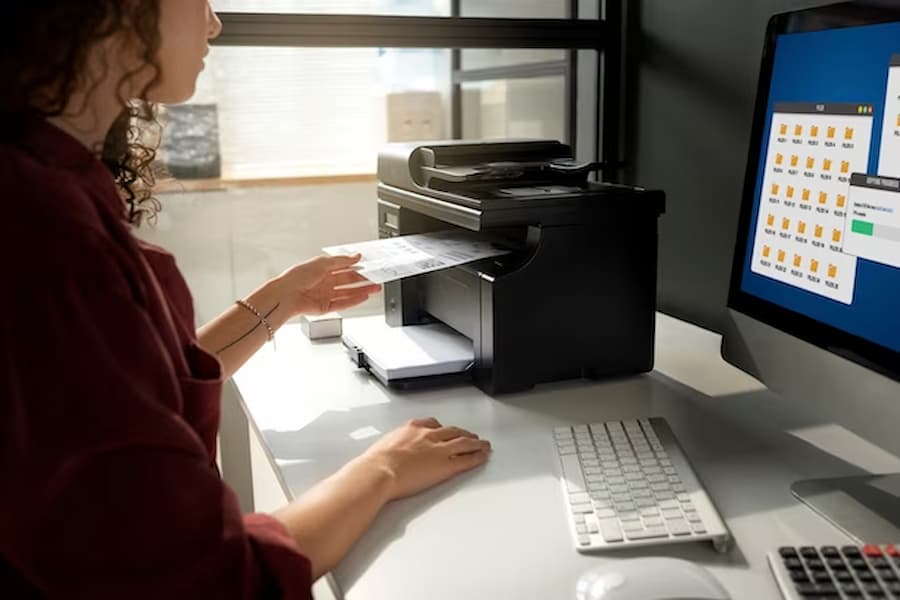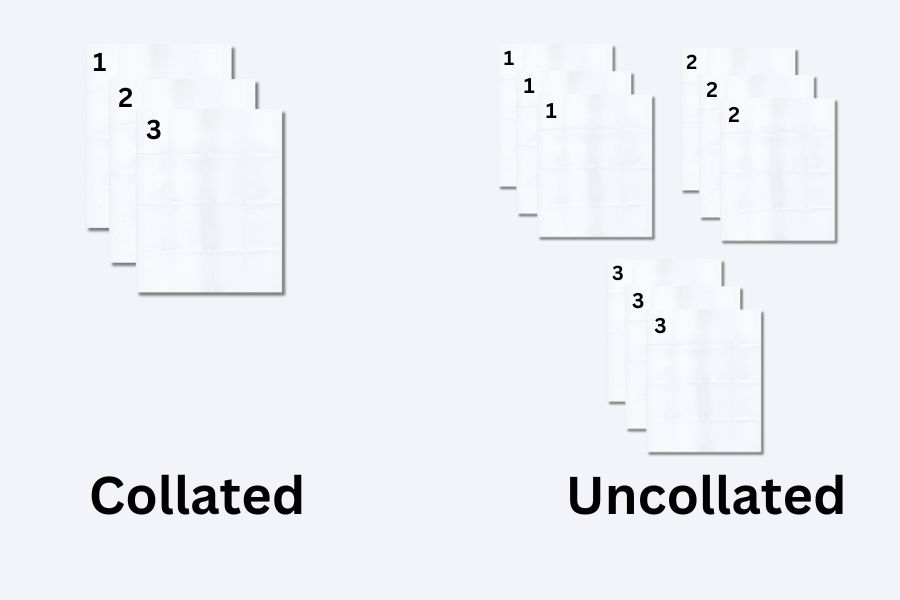The Essential Printer’s Guide: What Does Collated Mean When Printing?
What Does Collated Mean When Printing?
A collated printing term frequently encountered in the realm of modern printing refers to the process of arranging printed pages in a specific, sequential order. This method is particularly crucial when dealing with multiple-page documents, ensuring that each set of printed material follows a coherent and logical sequence. In the bustling world of printing, where efficiency and accuracy are paramount, the role of collated printing becomes indispensable.
The importance of collated printing in contemporary printing practices cannot be overstated. It streamlines the organization of printed materials, especially in environments where large volumes of documents are produced regularly. For instance, in corporate settings, educational institutions, and even in personal use, collated printing saves valuable time and resources. It eliminates the tedious task of manually sorting pages, thereby enhancing productivity and reducing the margin for error.
The Process of Collating in Printing
In the intricate process of collating, a printer is programmed to print multiple copies of a multi-page document in a specific order. This means that if you’re printing ten copies of a 20-page report, the printer will produce each copy as a complete set, from the first page to the last, before starting on the next copy. This method is in stark contrast to uncollated printing, where the printer would print ten copies of the first page, then ten of the second, and so on, leaving the task of organizing the pages to the user.

The differences between collated and uncollated printing are significant, particularly in terms of efficiency and usability. Collated printing, as Smart Technology elucidates, is akin to creating a complete booklet for each copy, where every page follows in the correct sequence. This is especially beneficial when producing documents like reports, brochures, or manuals, where the order of information is critical.
Collated printing offers a streamlined and efficient approach to handling multi-page documents, ensuring that each copy is a mirror image of the others in terms of page order. This method is indispensable in modern printing, where the demand for quick, accurate, and organized printing solutions is ever-growing.
Benefits of Collated Printing
Collated printing, a cornerstone in the realm of modern printing services, offers a plethora of benefits, paramount among which is its time-saving aspect. When you opt to print collated, you’re essentially instructing the printer to organize multiple sheets into sets of documents in the correct order. This process eliminates the need for manual sorting, a task that can be both time-consuming and prone to errors.
Convenience in document handling is another significant advantage. Imagine the scenario of printing a multi-page document like a report or a presentation. With the collate option enabled, each copy comes out in the correct sequence, ready for immediate use. This is particularly beneficial in fast-paced environments where efficiency is key. For instance, in a busy office setting, the ability to print multiple copies of a 20-page report, each perfectly sequenced, is a substantial time-saver.
Accuracy and organization in print jobs are further enhanced by collated printing. When pages are printed in a logical order, the risk of misplacing or mixing up sheets is significantly reduced. This is crucial in maintaining the integrity of the printed material, especially when dealing with important documents. In addition, the collate function ensures that each set of printed pages reflects the original document in both content and order, thereby upholding the professionalism and precision of the printing project.
Common Use Cases for Collated Printing
Collated printing finds its application in various domains in the diverse world of printing. Reports and presentations, for instance, benefit immensely from this method. When printing multiple copies of a report, the collate option ensures that each copy is a complete set, maintaining the predetermined order of pages. This is vital for clear communication and the effective presentation of information.
The importance of collated printing in manuals, instructions, and guides cannot be overstated. These documents often contain detailed, step-by-step information where the sequence of pages is crucial. Collated printing ensures that these multi-page documents maintain their intended order, facilitating ease of understanding and use. For example, a user manual for a complex device would not be as effective if the pages were not in the correct sequence.
collated printing, a term synonymous with efficiency and organization in the printing industry, is indispensable in various printing scenarios. Whether it’s for book printing, creating brochures, or producing color copies, the ability to print documents in a sequential order simplifies the process and enhances the overall quality of the printed material. This method, a staple of both online printing services and traditional printing presses, underscores the evolution and sophistication of modern printing techniques.
How to collate on printer
Have you ever faced the daunting task of manually arranging pages of a multi-page document? If so, you’ll appreciate the wonders of the collate option in printing. This feature, often overlooked, is a lifesaver in organizing documents efficiently. Let’s delve into how this simple yet powerful tool can transform your printing experience.
Understanding the Collate Option
When you’re ready to print a document, a dialogue box pops up after you click ‘print document’. Here, you’ll typically find the collate option, usually checked by default. It’s represented by an icon showing three stacked sheets of paper. This small checkbox is your gateway to hassle-free document organization.
By selecting this option, you instruct your printer to automatically arrange the pages of your document in the correct sequence. It’s like having an invisible assistant who meticulously sorts your pages, ensuring each copy of your multi-page document is in perfect order.
The Convenience of Collated Printing
Imagine printing multiple copies of a report or a presentation. Without collation, you’d end up with stacks of individual pages, which you’d then have to sort manually. With the collate option enabled, your printer does all the sorting for you. Each set of documents comes out in the right order, ready for use. This feature is particularly handy when dealing with large documents or when you’re pressed for time.
Collating in Different Scenarios
Collation isn’t just limited to standard documents. When printing PDFs and setting the option to print more than one copy, the collate checkbox automatically appears. This ensures that each set of your PDF documents is printed in the correct order.
However, it’s important to note that collation works best with documents that have similar characteristics. For instance, if you’re printing a batch of identical reports, collation is a breeze. But when it comes to diverse items like business cards and product catalogues, automated collation might not be the best fit. In such cases, manual collation is the way to go.
the collate option in printing is a small feature with big benefits. It streamlines the printing process, making it more efficient and less stressful. Whether you’re printing at home or in the office, give collation a try and see the difference it makes. Say goodbye to the days of manually sorting pages – let your printer do the work for you!
The Benefits of Collation
The beauty of using the collate option lies in its simplicity and effectiveness. It saves you time and the hassle of manually organizing pages. Once you start using it, you’ll wonder how you ever managed without it. The printer does the heavy lifting, leaving you with perfectly organized documents every time.
Technical Aspects of Collating
Navigating the technicalities of collating in printing can seem daunting, but it’s simpler than it appears. The key lies in understanding how to enable or disable the collate function in print settings. This capability varies across different operating systems and printers, but the core concept remains consistent.

To enable collating, typically, you access the print dialog box when you’re about to print a document. Here, you’ll often find an option labeled “Collate” or something similar. By selecting this option, you instruct the printer to print collated copies. Conversely, deselecting it results in uncollated printing. This feature is particularly useful when printing multiple copies of multi-page documents, ensuring each copy is a complete set in the correct order.
The process of collating can differ slightly depending on the operating system or printer model. For instance, in Windows, the collate option is usually found directly in the print dialog box, whereas on a Mac, you might need to delve a bit deeper into the print settings. Similarly, different printers have their own ways of handling this function. It’s always a good idea to consult the printer’s manual or online resources for specific instructions.
What People Also Ask
What Does Collate Mean in Printer Settings?
In printer settings, “collate” refers to the automatic arrangement of printed pages into sets. When this option is selected, the printer organizes the pages of multiple copies in a sequential order, page by page.
How Do I Choose Between Collated and Non-Collated Printing?
The choice depends on your needs. Choose collated printing when you need multiple copies of a document in the correct page order. Opt for non-collated printing if you need multiple copies of individual pages.
Can all printers perform collated printing?
Most modern printers offer the collate function. However, it’s best to check your printer’s capabilities, as some older or basic models might not support this feature.
Conclusion
In conclusion, collated printing stands as a beacon of efficiency and organization in the printing world. It simplifies the process of handling multiple-page documents, ensuring each copy is in the correct order. This method is invaluable in various scenarios, from book printing to creating comprehensive reports.
Remember, the key to successful collated printing lies in understanding your printer’s settings and capabilities. Whether you’re using online printing services or a local printing press, the option to collate can significantly impact the outcome of your printing project.
In the ever-evolving landscape of the printing industry, staying informed about these functionalities is crucial. Collated printing, with its ability to streamline processes and enhance productivity, is a testament to the advancements in printing technology. Whether you’re dealing with collated or uncollated copies, the goal remains the same: to produce quality printing that meets your specific needs.
So, the next time you’re faced with a printing task, consider the benefits of collated printing. It might just be the solution you need to ensure your documents are as effective and professional as possible.
You can contact us by phone, email, or by visiting our offices:
- Phone: (386) 261-8323
- Email: contact@smarttechfl.com
- Address: 771 Fentress Blvd. #10, Daytona Beach, FL 32114











